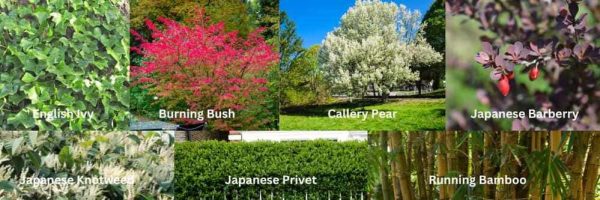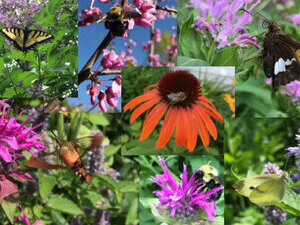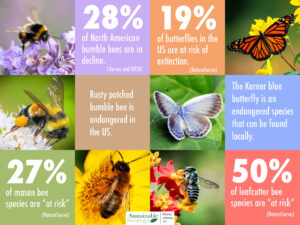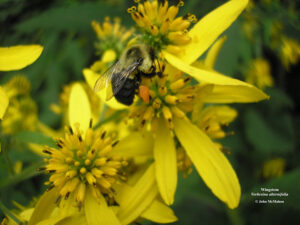Native and Invasive Plants

Native plants are the indigenous terrestrial and aquatic species that have evolved and occur naturally in a particular region, ecosystem, and habitat. Species native to North America are generally recognized as those occurring on the continent prior to European settlement.
Benefits of planting native species
When you select the appropriate plants for your area and conditions, they are adapted to the local environment and soil conditions. Once established, they are low maintenance, and don’t require as much in the way of irrigation. They don’t need fertilizer or insecticides.
Most importantly, native plants provide the best food and habitat for the native wildlife that evolved alongside them, including pollinator insects. While many native plants provide food and habitat for pollinators, Keystone species are those on which other species in an ecosystem largely depend, such that if they were removed, the ecosystem would change drastically. Planting Keystone species of plants provides the maximum benefit to pollinators. Download the list of Keystone plant species for butterflies and bees in our area from the National Wildlife Federation.
Invasive plants are destroying habitats and starving pollinators
Invasive non-native species of plants spread and cause ecological or economic harm to their new environment. They adversely affect the food web by suppressing the growth of native plant species, which have co-evolved with native animals in the region and which are necessary for their survival. Not all introduced plants are invasive: many non-invasive exotic plants do not spread on their own or escape their plantings to outcompete native species. But even non-invasive introduced plants have low food value for our native animals compared to the plants that occur here naturally.

Invasive species threaten nearly every aspect of our world and are one of the greatest threats to biodiversity. They cause or contribute to habitat degradation and loss, and the loss of native fish, wildlife, insects, and plant and tree species. Get started on identifying them in your area. Many plant identification apps provide information on native region a plant.
Here are a couple of lists of plants considered invasive in our area from NYUp.com and Gardening Know How. You can also download the New York State list of regulated/prohibited plants, or visit the Cornell Cooperative Extension regional PRISM (Partnership for Regional Invasive Species Management) website: https://www.capitalregionprism.org/
Read our post for more details and information about replacing invasive plants in your yard with native Keystone plants.
Non-native vs invasive
There are many non-native plants imported from other continents that are relatively well-behaved and don’t threaten our native plants. What’s wrong with planting them?
Because these non-native plants didn’t evolve alongside native animals, birds, and insects, most do not provide the nutritious food or habitat our pollinators need. Even if you see many insects buzzing around your Japanese xxx, the nectar and pollen they provide may not provide a high level of nutrition. Just like us and junk food: It may taste good, but it’s not going to fuel us through that workout. Our pollinators are under severe threat, and they take up space that could be used for native species. Some experts recommend limiting non-native plants to no more than 30% of the total plant material in your yard.
What does this all mean for pollinators?


Resources for gardening with native plants
- Replace your invasive species with Keystone plants
- Lose the Lawn – Create a Pollinator Paradise
- Create a native pollinator garden from scratch
- Start planning your pollinator garden
- Growing native species for pollinators throughout the year
- Did you pick up one of our native wildflower seed packets at an event? Here’s what’s in our seed packets and how to plant them.
- List of New York State threatened, endangered and rare native plants
- Need info on composting? Check out our composting resources.
Capital Region Wild Ones provides a list of local nurseries that sell sustainably grown native plants: https://capitalregionny.wildones.org/local-nurseries/




